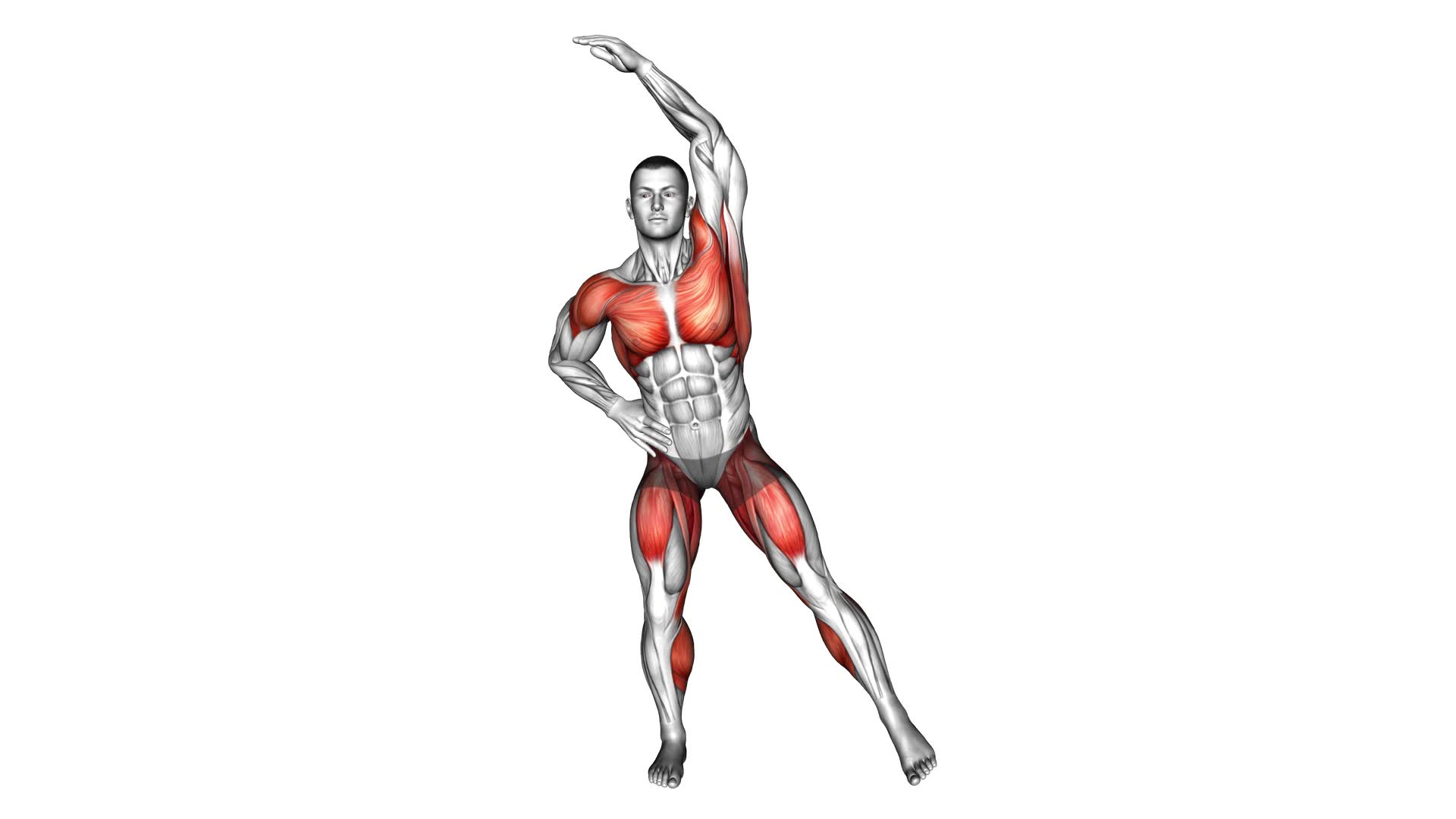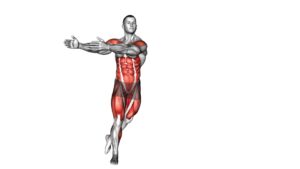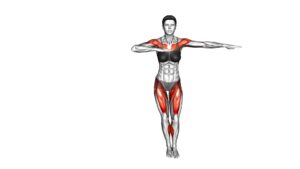Side Step Overhead Swing (male) – Video Exercise Guide & Tips

Looking to amp up your workout routine? Check out this video exercise guide and tips for the Side Step Overhead Swing.
Watch This Exercise Video
This dynamic movement targets multiple muscle groups, helping you build strength and improve coordination.
With proper form and technique, you can maximize your results and take your fitness to the next level.
Grab your gear and get ready to sweat – it's time to step up your game!
Key Takeaways
- The side step overhead swing targets multiple muscle groups and builds strength.
- This exercise improves coordination and increases core strength.
- It enhances shoulder mobility and can be modified by using heavier or lighter weights.
- Engaging core muscles properly and avoiding excessive momentum are key for maximizing results.
Benefits of the Side Step Overhead Swing
Experience the many benefits of the Side Step Overhead Swing by incorporating it into your workout routine. This exercise is a great way to improve your core strength and increase shoulder mobility.
When performing the Side Step Overhead Swing, you engage your core muscles to stabilize your body as you swing the weights overhead. This constant engagement helps to strengthen your core, including your abdominal muscles, obliques, and lower back. By regularly incorporating this exercise into your routine, you can expect to see improvements in your core strength over time.
In addition to improving core strength, the Side Step Overhead Swing also helps to increase shoulder mobility. As you swing the weights overhead, you're extending your arms and shoulders, which helps to improve flexibility and range of motion in these areas. This can be particularly beneficial for individuals who participate in activities that require a wide range of motion, such as throwing, swimming, or playing tennis.
Proper Form and Technique
To perform the Side Step Overhead Swing with proper form and technique, follow these steps:
- Start by standing with your feet shoulder-width apart and holding a dumbbell or kettlebell in one hand.
- Take a step to the side with the opposite foot, keeping your knees slightly bent and your back straight.
- As you step, swing the weight diagonally across your body and overhead, extending your arm fully.
- Return to the starting position by stepping back to the center and lowering the weight back down.
- Repeat on the other side.
To ensure proper form, avoid common mistakes such as using momentum to swing the weight instead of relying on your muscles. It's important to engage your core and focus on controlled movements throughout the exercise. This will help target the desired muscle groups, which include the shoulders, back, and core.
Now that you know the proper form and technique for the Side Step Overhead Swing, let's move on to the equipment needed for this exercise.
Equipment Needed for the Exercise
You will need a dumbbell or kettlebell for the Side Step Overhead Swing exercise.
Before starting the exercise, it's important to warm up your body to prevent injury. Warm up exercises such as arm circles, shoulder rolls, and leg swings can help prepare your muscles and joints for the movement.
Now, let's focus on some common mistakes to avoid during the side step overhead swing.
One mistake is using too heavy of a weight, which can compromise your form and increase the risk of injury. It's important to choose a weight that challenges you, but still allows you to maintain proper technique.
Another mistake is using momentum rather than controlled movements. Remember to engage your core and use the strength of your muscles to perform the exercise, rather than relying on momentum.
Lastly, avoid arching your back excessively during the overhead swing. Keep your core tight and maintain a neutral spine throughout the movement.
Variations and Modifications
Try incorporating different weights into your Side Step Overhead Swing routine to challenge your muscles and enhance your workout. By using heavier weights, you can increase the intensity and build strength. On the other hand, if you're just starting out or prefer a lighter workout, you can use lighter weights or even resistance bands. This allows you to modify the exercise based on your fitness level and goals.
Another modification you can make is to vary the tempo of your swings. Instead of performing the exercise at a steady pace, try slowing down the movement to engage your muscles for a longer duration. This can help improve muscle endurance and control.
If you're looking for alternative exercises that target similar muscle groups, you can try the kettlebell swing or the dumbbell swing. These exercises also engage your core, glutes, and shoulders, providing a full-body workout. Additionally, you can incorporate the side step into other exercises, such as lunges or squats, to further challenge your lower body and improve coordination.
Remember to listen to your body and adjust the modifications based on your comfort and ability. Always consult with a fitness professional if you have any concerns or questions about proper form and technique.
Tips for Maximizing Results
By incorporating these tips, you can maximize your results and take your Side Step Overhead Swing routine to the next level.
To ensure that you're getting the most out of your workout, it's important to avoid common mistakes that can hinder your progress. One common mistake isn't engaging your core muscles properly. Remember to tighten your abs and keep them engaged throughout the entire exercise. This won't only help you maintain proper form but also maximize the effectiveness of the movement.
Another mistake to avoid is using too much momentum. Instead of relying on swinging your arms forcefully, focus on using controlled and deliberate movements. This will target your muscles more effectively and prevent unnecessary strain on your joints.
In addition to avoiding these mistakes, it's also recommended to incorporate other workout routines that target your core and upper body strength. By including exercises such as planks, push-ups, and shoulder presses into your fitness routine, you'll further enhance the benefits of the Side Step Overhead Swing.
Remember to listen to your body and start with a weight that's challenging but manageable. With these tips, you can maximize your results and achieve your fitness goals faster.
Frequently Asked Questions
How Many Calories Can Be Burned by Performing the Side Step Overhead Swing Exercise?
You can burn a significant number of calories by performing the side step overhead swing exercise. This exercise is known for its calorie-burning benefits.
It engages multiple muscle groups and requires a lot of energy, leading to an increased calorie burn.
Incorporating this exercise into your workout routine can help you achieve your fitness goals and improve your overall health.
Can the Side Step Overhead Swing Exercise Help in Improving Balance and Coordination?
Yes, the side step overhead swing exercise can definitely help improve your balance and coordination.
By incorporating this exercise into your routine, you'll see an improvement in your stability and coordination skills.
The benefits of coordination training are numerous, as it helps enhance your overall movement, reaction time, and body control.
Is It Safe to Perform the Side Step Overhead Swing Exercise for Someone With a History of Shoulder Injuries?
If you have a history of shoulder injuries, it's important to take precautions when performing the side step overhead swing exercise. Consult with a medical professional or a trainer to determine if it's safe for you.
If it's not recommended, there are alternative exercises that can help improve balance and coordination without putting strain on your shoulders.
Remember to prioritize your safety and listen to your body during any exercise routine.
Can the Side Step Overhead Swing Exercise Be Included in a Full-Body Workout Routine?
Including the side step overhead swing exercise in your full-body workout routine can offer several benefits.
This dynamic movement engages multiple muscle groups, including the shoulders, core, and legs, promoting overall strength and stability.
It also improves cardiovascular endurance and coordination.
To cater to different fitness levels, modifications and variations can be implemented.
Beginners can start with lighter weights or use a resistance band for assistance, while advanced individuals can increase the weight or incorporate a jump into the movement for an added challenge.
Are There Any Common Mistakes to Avoid While Performing the Side Step Overhead Swing Exercise?
When performing the side step overhead swing exercise, there are a few common mistakes to avoid.
One mistake is using improper form, such as bending your back too much or not engaging your core.
Another mistake is using too much momentum instead of relying on your muscles for the movement.
To ensure proper form, make sure to keep your back straight, engage your core, and use controlled movements.
Conclusion
In conclusion, the side step overhead swing is a beneficial exercise that targets multiple muscle groups and improves overall strength and coordination.
By following proper form and technique, using the necessary equipment, and incorporating variations and modifications, you can maximize the results of this exercise.
Remember to listen to your body and start with lighter weights before gradually increasing the intensity.
Stay consistent and dedicated to see the desired outcomes of this exercise.

Author
Years ago, the spark of my life’s passion ignited in my mind the moment I stepped into the local gym for the first time. The inaugural bead of perspiration, the initial endeavor, the very first surge of endorphins, and a sense of pride that washed over me post-workout marked the beginning of my deep-seated interest in strength sports, fitness, and sports nutrition. This very curiosity blossomed rapidly into a profound fascination, propelling me to earn a Master’s degree in Physical Education from the Academy of Physical Education in Krakow, followed by a Sports Manager diploma from the Jagiellonian University. My journey of growth led me to gain more specialized qualifications, such as being a certified personal trainer with a focus on sports dietetics, a lifeguard, and an instructor for wellness and corrective gymnastics. Theoretical knowledge paired seamlessly with practical experience, reinforcing my belief that the transformation of individuals under my guidance was also a reflection of my personal growth. This belief holds true even today. Each day, I strive to push the boundaries and explore new realms. These realms gently elevate me to greater heights. The unique combination of passion for my field and the continuous quest for growth fuels my drive to break new ground.







